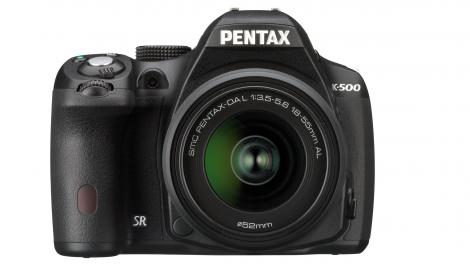
Introduction
The rise of the compact system camera has made it a tough time in recent years for the entry-level DSLR, which may explain why Pentax hasn’t rushed to replace its ageing K-r junior model. But, better late than never, the K-500 steps in to fill the vacant bread-and-butter end of the company’s DSLR range.
In essence the K-500 is the same camera as the new mid-range K-50 that Pentax recently introduced to replace the K-30. The key differences between the new siblings are that the K-500 has to do without weather sealing, and its autofocus system lacks any AF point display in the viewfinder.
But given Pentax’s history of producing well made beginner DSLRs with good specs, can the K-500 prove a worthy alternative to the Canon 100D, Nikon D3200 and Sony A58?

Features
First impressions aren’t encouraging, however, suggesting Pentax is already playing catch-up with its established rivals.
At the heart of the K-500 is the same 16.3-megapixel APS-C CMOS sensor found in the old K-30. This kind of pixel count sounds a bit paltry by today’s standards, especially compared with Nikon’s 24MP chip in the D3200.
The sensor does, however, come equipped with Pentax’s Shake Reduction system, enabling it to shift enough to allow shutter speeds up to three stops slower while retaining sharp shots. Having such a system in the camera body rather than the lens carries the added bonus that you can attach almost any K-mount compatible lens and still maintain a stabilised image.
When Shake Reduction isn’t enough and there’s no alternative but to crank up the sensor sensitivity, the K-500’s PRIME M processing engine should be up to the job.
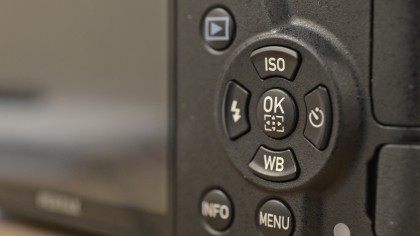
It’s another element borrowed from the K-30, but Pentax has given it a few tweaks in an effort to improve image quality and low-light performance. Consequently the K-500 can boast a maximum sensitivity of ISO 51200; a stop higher than Canon’s 100D and comfortably more than Nikon or Sony’s equivalent offerings.
The boosted processing also helps the K-500 reach a respectable 6fps burst shooting rate at full resolution for superior performance when capturing fast sports. If even this shooting speed won’t cut it, you can always switch to video recording at Full HD resolution at a choice of 30, 25 or 24 frames per second.
To ensure all this processing speed isn’t held up by sluggish autofocusing, Pentax has employed its SAFOX IXi+ autofocus module, again shared with the K30 and K50. It features 11 selectable autofocus points, of which an impressive nine are the more sensitive cross type.
See it all
Although the viewfinder doesn’t display any of these autofocus points, its glass pentaprism’s 100% field of view will show elements on frame fringes that similar cameras often hide, meaning you won’t have to waste time cropping out unwanted extras.
The K-500 includes the usual array of scene modes as well as 19 effects filters, making the transition from an advanced compact or bridge camera a little easier.
You also get a useful HDR function whereby the camera captures three images at varying customisable exposures and automatically tone maps them into a single image with increased highlight and shadow detail.
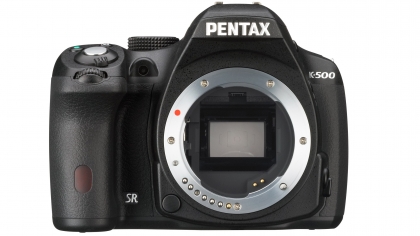
Another nice touch is the battery compartment. This will house either the included 410-shot capacity rechargeable Lithium-ion cell, or alternatively you can slot in 4 standard AA batteries with the aid of an optional holder. It’s a great feature if you’re travelling without regular mains access.
Build quality & handling
The fit and finish of Pentax’s lower-end DSLRs often exceeds what you’d expect for the money, and the K-500 continues this tradition with plastic casing that feels solid enough to withstand some light abuse.
Grippy rubberised sections on both sides of the camera help the ergonomics, while the chunky hand grip is large enough to grasp comfortably but still retains compact overall dimensions. You don’t, however, get a rubberised rear thumb grip, which makes the camera feel slightly less secure when shooting one-handed.
In control
We’ve got no complaints when it comes to the controls though. The K-500 is the only camera in its class to feature a pair of control wheels; a feature more often associated with mid-range models, giving you the ability to adjust shutter speed and aperture independently.
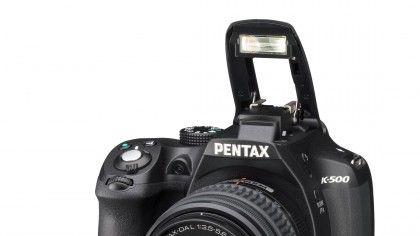
There are also dedicated buttons for changing ISO sensitivity and white balance, avoiding any need to hunt around in menus.
Up top is a standard mode dial to select between full auto, program auto, shutter and aperture priority modes, plus full manual control. Pentax also includes a combined aperture and shutter priority mode as well as a sensitivity priority setting.
You even get a specific bulb mode on the main dial for long exposure shots, in addition to a pair of user-customisable presets to store your own custom settings. It all helps make the K-500 a versatile camera that’s able to adapt quickly to different shooting conditions.

It’s perhaps a little disappointing that more hasn’t been done to update the LCD monitor and menu interface. The screen’s 921k-dot resolution is certainly crisp and provides excellent viewing angles, but the unit isn’t movable – so you’ll still have to get creative with your posture when composing high- or low-level shots.
There’s no touch sensitivity either, but thankfully the menu interface – though a bit dated in its design – is clear and easy to navigate.
Tweaking common settings such as focusing, metering and dynamic range enhancements can be achieved via a quick settings menu accessed by the Info button. Here you can also adjust the K-500’s ability to automatically correct lateral chromatic aberrations and lens distortion.
Performance
Strangely for a camera, the first thing that strikes you when shooting with the K-500 is noise. The 18-55mm DAL kit lens has to make do without an internal autofocus motor, instead relying on the screw-drive from the camera body.
It’s actually reasonably rapid to focus, but significantly louder than most lens-based systems, resulting in unsettlingly conspicuous shooting in quiet environments.

But this isn’t the biggest problem with the K-500’s autofocus system: Pentax’s decision to remove any indication of autofocus points from the viewfinder display makes it relatively tricky to establish exactly where the camera is focusing. If you don’t have time to review your shots, you’ll invariably find some haven’t focused quite where you’d intended.
Of course switching to selectable-point autofocus can help, but trying to cross reference the focus points displayed on the LCD monitor with the composition visible through the viewfinder still requires some guesswork. Focus-critical shots therefore become trickier to achieve than with similar cameras.
It’s not a major issue, but then it’s not the only performance problem. We found the K-500’s exposure metering to consistently underexpose under bright skies by around one stop, with occasionally as much as two stops of positive correction needed to retain good shadow detail.
The exposure compensation button is well sited to make these adjustments, while switching to centre-weighted or spot metering can also improve things. But it’s a pity matrix metering isn’t more reliable.
Fortunately auto white balance has much better accuracy and is rarely fazed by incandescent or mixed lighting environments.
This, combined with the K-500’s faithful colour reproduction, enables the default Bright colour preset to produce a punchy yet natural colour palette, including tricky hues like reds and pinks. However if you’d rather change the camera’s colour balance to suit your own taste, just fire up the quick settings menu.
Despite having a relatively low outright pixel count, detail is very well resolved throughout the sensitivity range. Granted, you won’t get the same cropping potential that higher resolution shots provide, but there’s more than enough scope for high quality A3 prints.
At higher sensitivities Pentax’s image processing tweaks have kept both luminescence and chroma noise in check right up to ISO3200 and you can even make decent normal sized prints from shots taken as high as ISO6400.
Dynamic range isn’t quite as impressive at default settings. Activate the shadow and highlight correction features, though, and high-contrast scenes can be noticeably subdued.
The K-500’s multi-shot HDR feature further boosts dynamic range and does so with great results. A choice of exposure variations and tone mapping intensities enable you to achieve subtle contrast enhancements through to more stylistic effects.
The only drawback is around a 10-second processing time, though that’s still a marked improvement over the speed of the K5-II‘s system.
Image quality and resolution
As part of our image quality testing for the Pentax K-500, we’ve shot our resolution chart.
If you view our crops of the resolution chart’s central section at 100% (or Actual Pixels) you will see that, for example, at ISO 100 the Pentax K-500 is capable of resolving up to around 24 (line widths per picture height x100) in its highest quality JPEG files.
For a full explanation of what our resolution charts mean, and how to read them, check out our full explanation of our camera testing resolution charts.
Examining images of the chart taken at each sensitivity setting reveals the following resolution scores in line widths per picture height x100:
JPEG

Full ISO 100 image, see the cropped (100%) versions below.

ISO 100, score: 24 (Click here to see full resolution image)
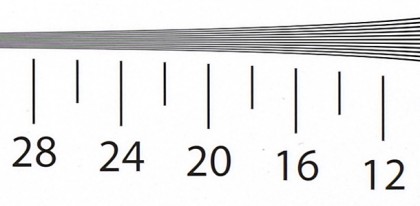
ISO 200, score: 24 (Click here to see full resolution image)
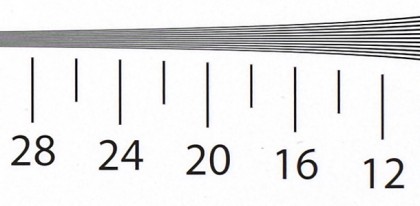
ISO 400, score: 24 (Click here to see full resolution image)
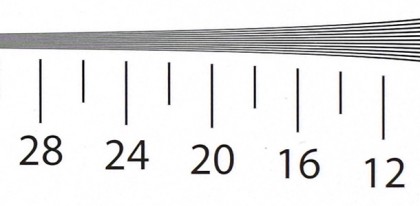
ISO 800, score: 22 (Click here to see full resolution image)
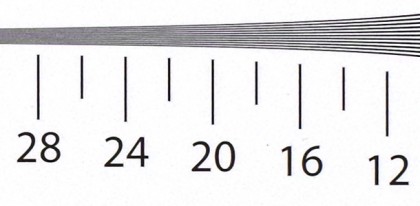
ISO 1600, score: 22 (Click here to see full resolution image)
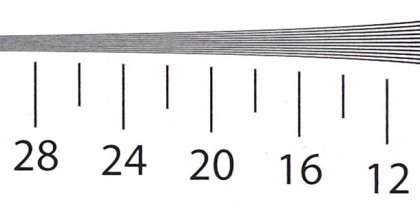
ISO 3200, score: 22 (Click here to see full resolution image)
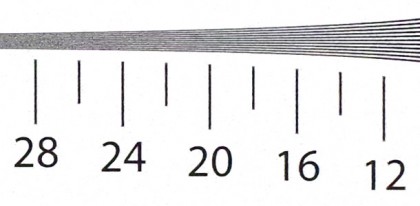
ISO 6400, score: 22 (Click here to see full resolution image)

ISO 12,800, score: 22 (Click here to see full resolution image)
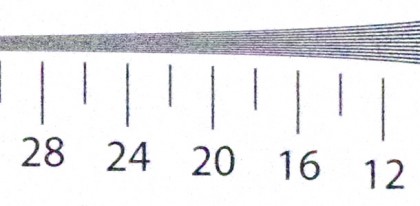
ISO 25,600, score: 20 (Click here to see full resolution image)
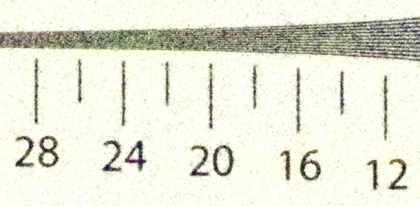
ISO 51,200, score: 12 (Click here to see full resolution image)
Raw

ISO 100, score: 24 (Click here to see full resolution image)
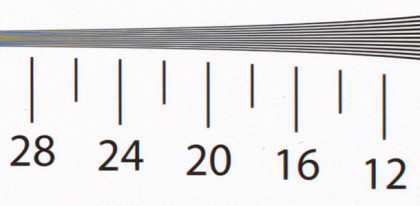
ISO 200, score: 24 (Click here to see full resolution image)
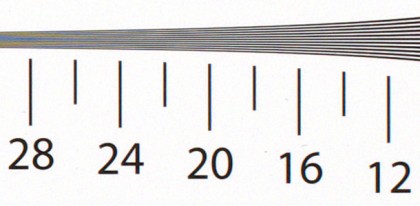
ISO 400, score: 24 (Click here to see full resolution image)
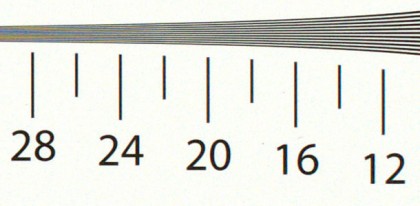
ISO 800, score: 22 (Click here to see full resolution image)
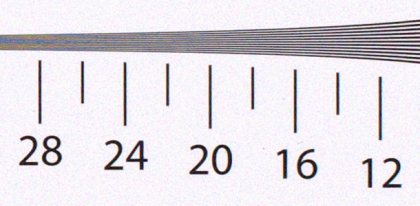
ISO 1600, score: 22 (Click here to see full resolution image)

ISO 3200, score: 22 (Click here to see full resolution image)

ISO 6400, score: 22 (Click here to see full resolution image)
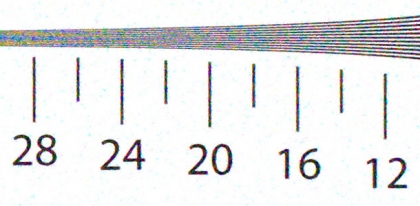
ISO 12,800, score: 18 (Click here to see full resolution image)
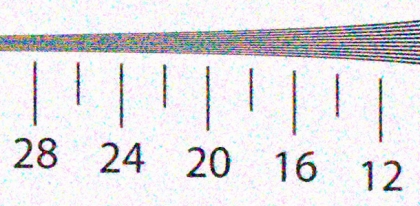
ISO 25,600, score: 18 (Click here to see full resolution image)

ISO 51,200, score: 12 (Click here to see full resolution image)
Noise and dynamic range
We shoot a specially designed chart in carefully controlled conditions and the resulting images are analysed using DXO Analyzer software to generate the data to produce the graphs below.
A high signal to noise ratio (SNR) indicates a cleaner and better quality image.
For more more details on how to interpret our test data, check out our full explanation of our noise and dynamic range tests.
JPEG signal to noise ratio
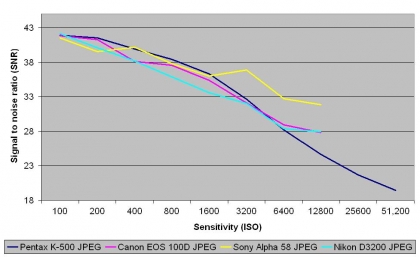
This graph demonstrates one of the benefits of restricting the Pentax K-500’s pixel count to 16 million as it produces cleaner images than most of the competing cameras at the low to mid sensitivity range. Its score drops off considerably at the highest settings, however, when noise becomes a much more significant issue.
Raw (converted to TIFF) signal to noise ratio
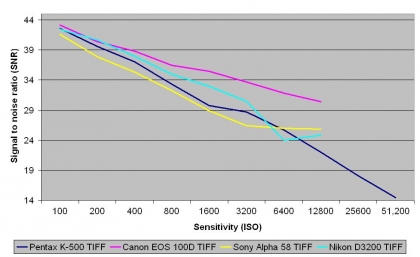
The raw file (after conversion to TIFF) results suggest that Canon and Nikon are prepared to mask more detail in an effort to hide noise in the JPEG files than Pentax. The results are good at the lower sensitivity settings, but the Canon 100D produces cleaner images from about ISO 400 and above. The Nikon D3200, which has a pixel count of 24 million also outperforms the K-500 in the low to upper-middle sensitivity range.
JPEG dynamic range
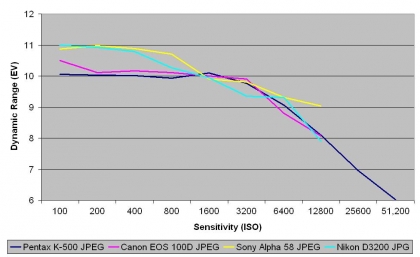
JPEG dynamic range figures tend to reflect the level of contrast that manufacturers want to give the images that their cameras produce. The Canon 100D and Pentax K-500 both produce quite punchy images with a pleasant level of contrast, whereas the Nikon D3200’s JPEGs exhibit greater tonal range.
Raw (converted to TIFF) dynamic range

Raw file dynamic range values give a better indication of a cameras ability to record different brightnesses in a single image. After conversion to TIFF the Pentax raw files have a very impressive dynamic range at the lowest sensitivity, beating the rest of the competition, but it dips quite sharply so that it is the lowest for most of the sensitivity range.
Sample images

Click here to see the full-resolution image
Shot with the K-500’s auto HDR function set to a 1-stop bracketing variation. Although the camera will auto-align the three source images, it’s best to keep the camera as still as possible to avoid possible ghosting effects.
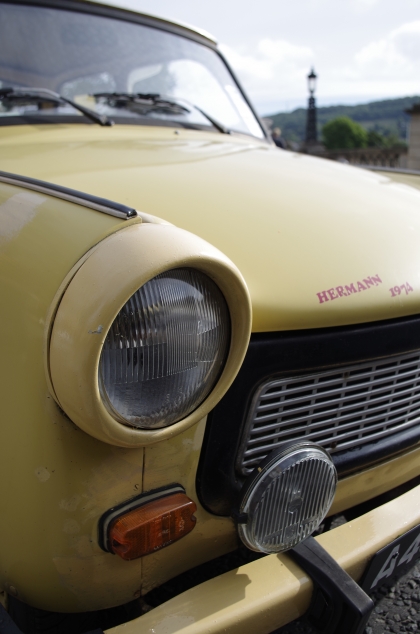
Click here to see the full-resolution image
Exposure metering works well providing areas of brightness like skies don’t occupy much of the frame. As you can see there’s still plenty of highlight detail in this image whilst shadows are also full of detail.

Click here to see the full-resolution image
A rare instance where matrix metering has focused on the shadow areas. Although the main light source has slightly blown highlights, the overall exposure looks good with plenty of shadow and mid-tone data.

Click here to see the full-resolution image
Despite the cloudy conditions for this shot, matrix metering was fooled by the brighter sky area, requiring a full 2-stops of positive exposure compensation to brighten up the rest of the scene.

Click here to see the full-resolution image
The K-500’s multi-image HDR effect can boost contrast subtly, or you can ramp up the tone mapping and get results like this. It’s not exactly true to life, but at least you don’t need additional software to create an image with this much impact.

Click here to see the full-resolution image
Despite ‘only’ having 16.28 effective megapixels at its disposal, the K-500 is easily capable of resolving plenty of fine detail.

Click here to see the full-resolution image
A moveable monitor would have really helped when composing this low-level shot. Instead your reviewer got some funny looks as he lay on the pavement under a life-sized model pig.

Click here to see the full-resolution image
Switch to aperture priority mode and you can create a shallow depth of field to isolate a delicate subject such as this. This image was shot using the kit lens and although its widest aperture isn’t particularly large, the resulting background bokeh blur is still pleasantly creamy.

Click here to see the full-resolution image
+2/3 exposure compensation helped avoid this photograph looking too murky; however, it could do with an even bigger brightness boost to offset the underexposing matrix metering.

Click here to see the full-resolution image
Cycling isn’t always as good for your health as some make out.

Click here to see the full-resolution image
This is about as close as you can get to a subject with the kit lens. Even so, detail is excellent, though 1-stop of positive exposure compensation was again required.

Click here to see the full-resolution image
Without a focus point display in the viewfinder, it can be tricky to establish exactly where the K-500 is locking on to. Fortunately these tomatoes weren’t in hot demand so there was time to switch to selective-point autofocus and cross-reference with the focus point display on the LCD monitor.

Click here to see the full-resolution image
With the camera’s colour balance preset set to Bright, colour reproduction is vibrant without looking oversaturated. Aperture priority mode helped bring the background elements into sharper focus and selective point autofocus encourage the K-500 to target the bottom elements of the image.
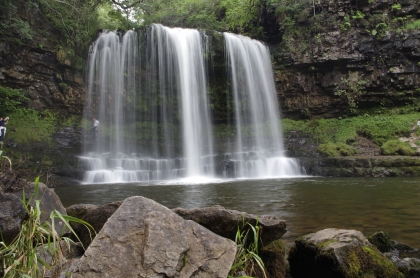
Click here to see the full-resolution image
Switch to aperture priority mode, set a narrow aperture and you can force a slow shutter speed to blur a waterfall like this. Just remember to take your tripod – or find a well-placed rock instead and hold your breath!

Click here to see the full-resolution image
Some cameras get confused by hot pink colours and render them incorrectly, but the K-500 has done well here and faithfully reproduced the correct hue.

Click here to see the full-resolution image
The camera’s 16MP sensor resolved a good amount of detail in this shot. The saved JPEG could use a little sharpening, but at least the K-500’s metering system has exposed the scene properly.
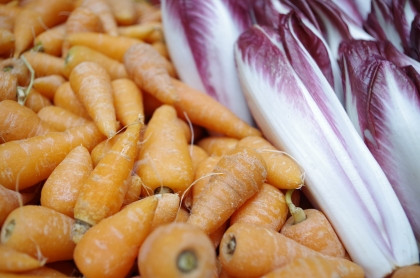
Click here to see the full-resolution image
1.3 stops of positive exposure compensation was required to get this shot properly exposed. The kit lens is capable of a nice shallow depth of field though, even close-range at f/4.

Click here to see the full-resolution image
The K-500 includes several effect filters, this being an example of the High Contrast setting.

Click here to see the full-resolution image
If you fancy a bit of a sci-fi look, try the Invert Colour effect.

Click here to see the full-resolution image
Selecting the Retro filter reduces colour saturation to create a soft, high-key style and also adds as a border for good measure.

Click here to see the full-resolution image
Go for the Toy Camera effect and you get a darkened exposure and a large vignette to frame it.
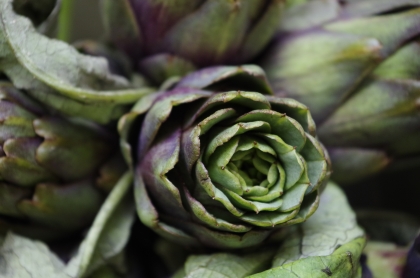
Click here to see the full-resolution image
Focusing this shot was a bit of a mission. It’s at the close-up limit of the kit lens, but with no focus point display in the viewfinder, establishing whether the camera has locked-on to the precise point you want takes time, trial and error.
Sensitivity and noise images
JPEG

Full ISO 100 image, see the cropped (100%) versions below.

ISO 100 (Click here to see the full-resolution image)

ISO 200 (Click here to see the full-resolution image)

ISO 400 (Click here to see the full-resolution image)

ISO 800 (Click here to see the full-resolution image)

ISO 1600 (Click here to see the full-resolution image)

ISO 3200 (Click here to see the full-resolution image)

ISO 6400 (Click here to see the full-resolution image)

ISO 12800 (Click here to see the full-resolution image)

ISO 25600 (Click here to see the full-resolution image)

ISO 51200 (Click here to see the full-resolution image)
Verdict
Pentax has come frustratingly close with the K-500 to producing an ideal entry-level DSLR. If you’re coming from an advanced compact or a bridge camera, the K-500’s range of scene modes and effect filters should make the transition a smooth one.
However, such little extras as user customisable modes and twin control wheels will also please those used to more advanced kit. Consequently this is a camera well suited to developing skill levels.
We liked
The K-500 shows that an entry-level DSLR doesn’t have to compromise features or control. Excellent image quality and build further enhance the camera’s appeal, as does the 100%-coverage viewfinder.
We disliked
Excluding any indication of focus points from the viewfinder makes focus-critical shots time consuming, while the regular underexposure with matrix metering can be equally irritating. Plus if you want to shoot inconspicuously, then the noisy focusing with the kit lens is likely to blow your cover.
Final verdict
Although there’s an impressive feature set for the money, the lack of any focus point display in the viewfinder is a small yet very noticeable omission. That, along with the K-500’s propensity to underexpose, makes it easy to lose faith in the camera’s autofocus and exposure metering abilities.
This is an even bigger shame given the strength of the camera’s image quality, especially in low light.
A DSLR at this price point will always be a compromise between cost, performance and functionality, and for the most part Pentax has struck a good balance with the K-500.
If you keep tabs on its enigmatic autofocusing and don’t mind dialling in some exposure compensation now and again, then this is a well made, well equipped and high performing DSLR for beginners and established photographers alike.
![]()












Leave A Comment